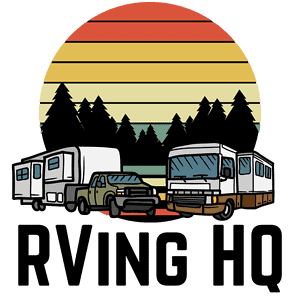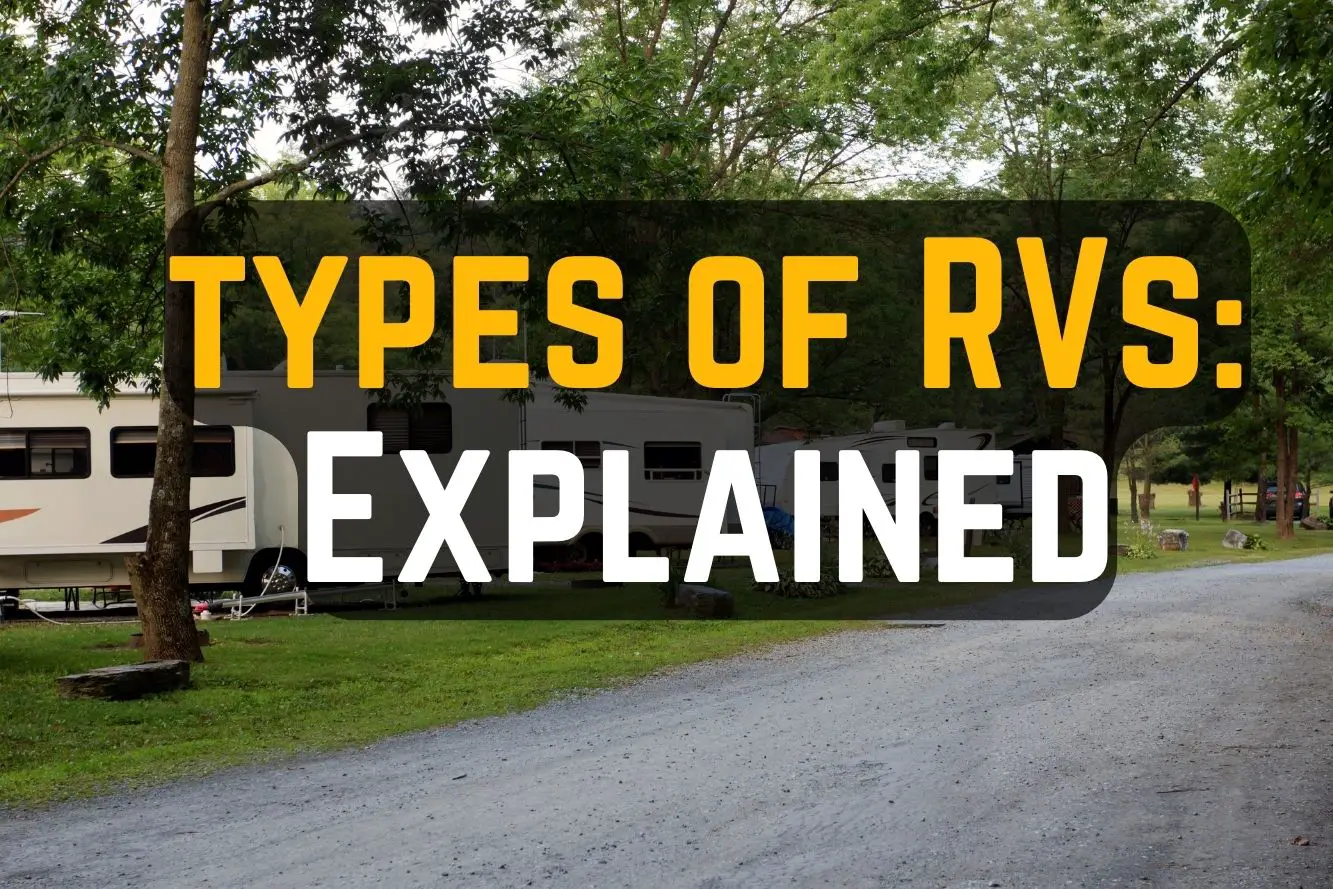What’s all the hype about RV types? There are 10+ RV classes and types of RVs… and if you don’t know how to tell the difference, you won’t know how to start the RV shopping process.
In this article, we’re diving into all the RV types to help you have a better understanding of exactly what kind of RVs and campers you see on the roads… And so you know how to start looking for the RV of your dreams.
Each RV type and RV class features a pros and cons list – these are all important things to consider if you’re in the market for an RV. Let’s get started.
Table of Contents
What Are the Types of RVs & RV Classes?
- Class A
- Class B RVs
- Class B+
- Class C
- Super C
- Bus Conversions
- Fifth Wheels
- Travel Trailers
- Hybrids
- Pop Ups
- Truck Campers
- Toy Haulers
- Teardrop Campers
Drivable RVs vs Towable RVs
Drivable RVs are called motorhomes and these types of RVs are built on motorhome, truck, and van chassis depending on the class. Motorhomes are the only types of RVs that are designated with a “Class” name – Class A, B, C, and so on.
Towable RVs come in several kinds: travel trailers, fifth wheels, truck campers, pop up campers, teardrop trailers, and hybrids. These types of campers attach to a vehicle (called a tow vehicle) on the bumper or in the truck bed.
Demystifying RV Types – Why All the Differentiation?
Why are there so many RV types? It’s simple: because there are many different personality styles, budgets, travel styles, preferences, and needs.
While some people might want to RV in luxury in a massive, motorized drivable coach, others might prefer the back-to-nature feel of a small tent camper. And others still might prefer to travel with the creature comforts yet compact size of a small travel trailer.
Every RV type has pros and cons. There is not a single RV type that is better than any other… RVing is a highly individual activity, so what works for one person might not work for others!
A Quick Note about RV Names to Clear Up Confusion
There are a lot of words that are used interchangeably to describe RVs. While some think “RV” only applies to the kind you can drive, the truth is that they’re all considered RVs.
RV and camper can be used to describe any kind of RV.
Travel trailers are also sometimes called bumper-pulls or camper trailers, and fifth wheels are also called “fivers”.
Pop up campers are also called tent campers or tent trailers. And truck campers are sometimes called “slide in campers” or “backpack campers”.
Types of Drivable RVs
There are 3 main types of drivable RVs: class A, B, and C. In this section, we’ll dive into each of these main types. We’re also going over subtypes and bus conversions – because you’ll see a lot of those on the road too.
Class A Motorhomes
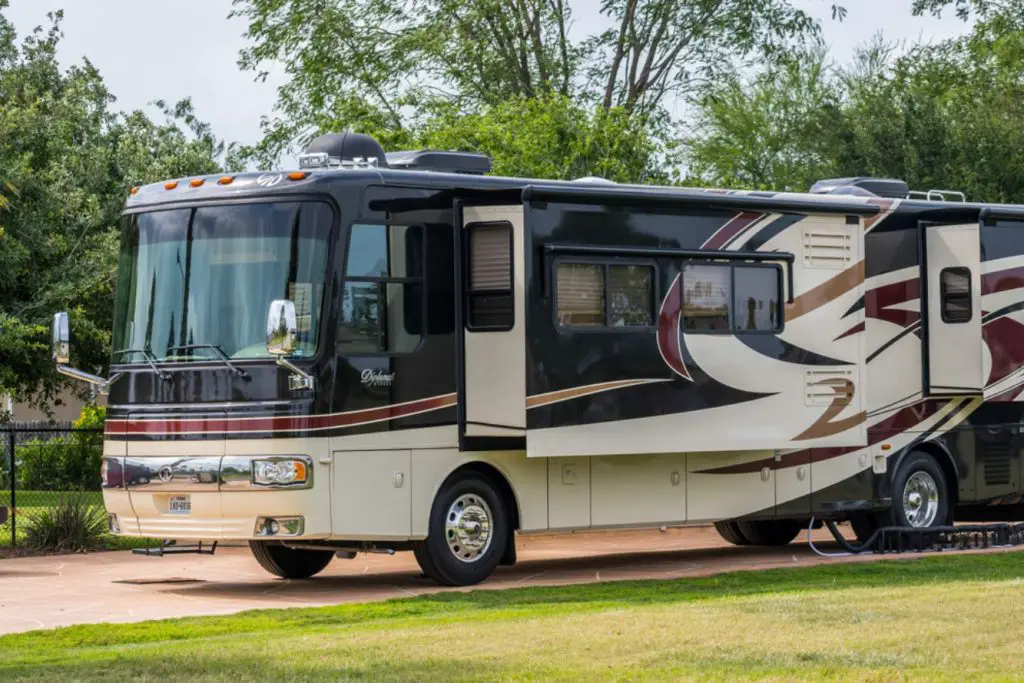
Class A motorhomes are the quintessential RV – this type of RV is probably what comes to mind for many people when they hear the words “RV” or “motorhome”.
These RVs are built on a special motorhome chassis and often look like a bus or a box on wheels. Class A motorhomes typically have a flat front and a flat rear and truly do look like a giant rectangular box on wheels.
This type of RV is a very popular RV type for full-time living. They come in many different lengths starting around 30 feet and going all the way up to 40 feet or longer. These RVs can come with or without slides and typically all have the same general layout.
Pros and Cons of Class A RVs
Pros
- Most spacious of the motorhome types.
- Most storage of all motorhome types.
- Large windshield and high seating offers a great view of the road and campsites.
- Many amenities of home.
Cons
- Driving these RVs can be intimidating.
- Tall height requires careful trip planning.
- Poor MPG.
- Very expensive.
- Campsites may be limited depending on the overall length of your RV.
Class B RVs
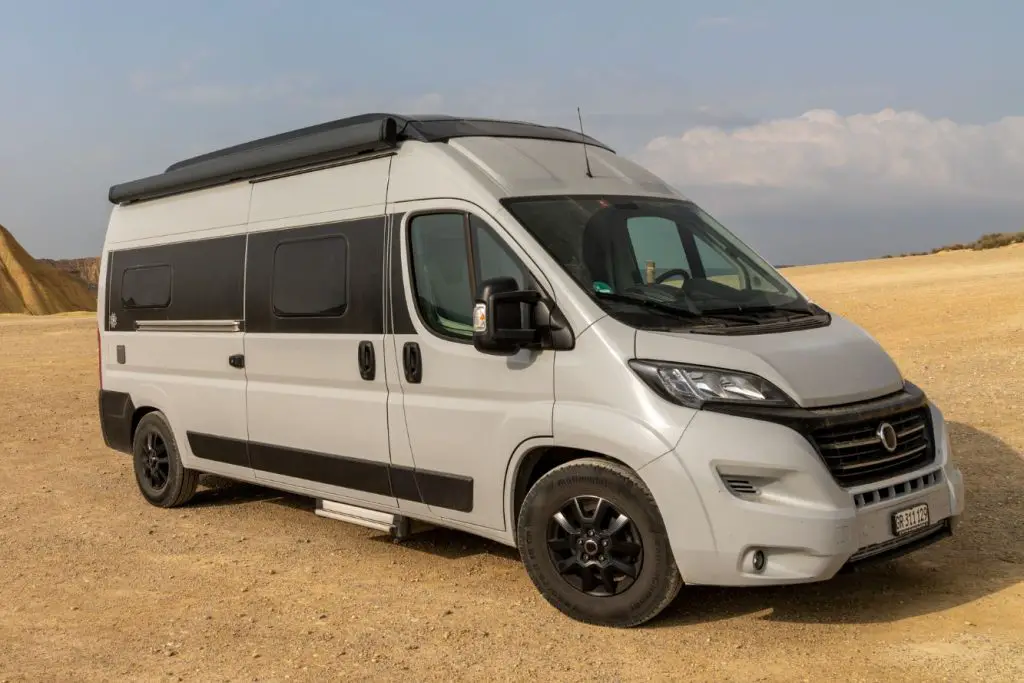
Class B RVs are built on van chassis – these are the typical van conversion RVs. The difference with DIY campervan conversions and class B RVs is that class B RVs are built by RV manufacturers.
Class B RVs are the smallest of all drivable RV types and as such, they are easy to drive and maneuver. They’re very nimble and most can fit in a regular parking space, so getting around with these is no problem!
These little RVs are built with every inch in mind – there is no wasted space in a class B. Depending on the size of the RV, class B RVs can have:
- A bed space
- A dining area
- A kitchen area with stove, sink, and refrigerator
- A small bathroom or wet bath with toilet and shower
These are popular for solo travelers or couples who want to hit the road but not be bogged down by a large RV.
Pros and Cons of Class B RVs
Pros
- Smallest and most nimble of the drivable RV types.
- Best on gas.
- Floor plans have very efficient use of space.
- Easy to store due to their small size.
Cons
- Most expensive RV type by square footage.
- Very small interior living and storage space.
- Very small holding tanks.
- Not all class B RVs have a bathroom or toilet.
Class B+ RVs
A B+ RV is a class B RV with more: a bigger size and more amenities.
Most class B+ RVs toe the line with small Class C RVs. These RVs don’t have a cabover space, but they offer more interior space, larger holding tanks, and more creature comforts.
Pros
- Larger than class B RVs in all aspects: floor plan, holding tanks, storage, etc.
Cons
- More expensive than regular class B RVs.
Related Reading about Class B RVs:
Class C RVs
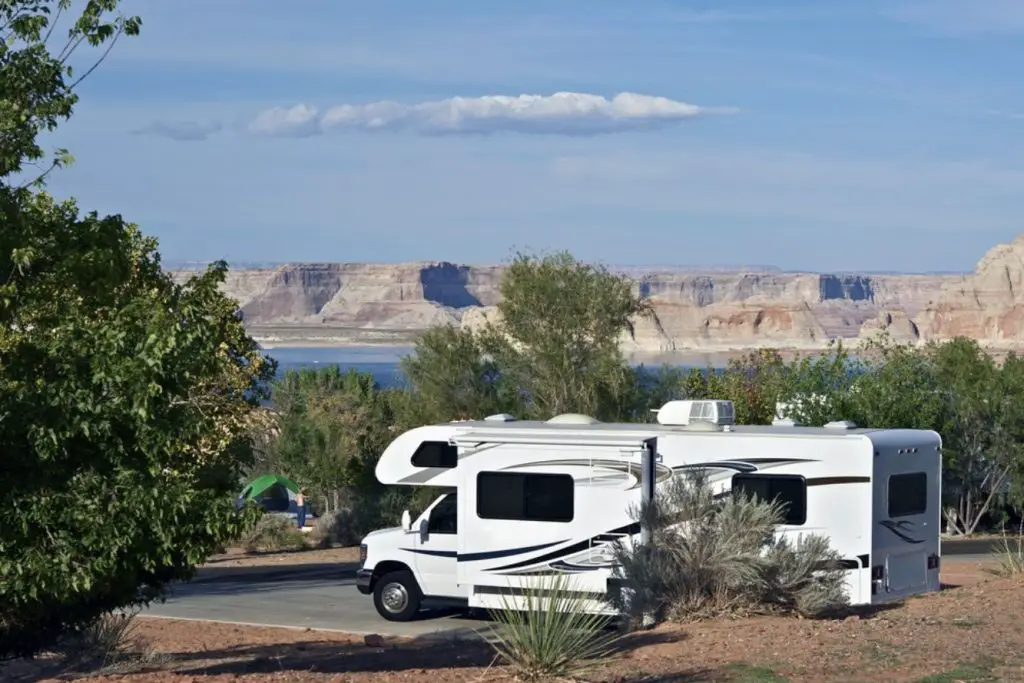
Class C RVs are built on a truck chassis and have a truck-like cab. You can tell a class C RV on the road by the signature cab-over area. The cab-over area is usually a bed, but in some RVs it serves as extra storage space or an entertainment center.
Class C RVs are the middle-of-the-road motorhome type: they’re not as long or as tall as Class A RVs, but they’re much bigger than Class B RVs.
These RV types are comfortable to drive and come in many different lengths. You’ll find them with slides or without, and they can have many of the amenities you’ll find in larger Class A motorhomes.
Pros and Cons of Class C RVs
Pros
- Typically the least expensive of the motorhome types.
- Decent amount of interior and exterior storage.
- Wide variety of lengths and brands available.
- Comfortable driving experience.
Cons
- Not great on gas.
- Not always suitable for families.
- Will need to tow a vehicle for errands and daily adventuring.
Super C Motorhomes
Super C RVs are just what they sound like: class C RVs that are souped up! These types of RVs are built on a heavy-duty truck chassis – some super C RVs look like they’re built on a semi engine… because they are.
These RVs have a lot more driving and towing power, and as such, can have much larger living spaces.
Super C RVs are a type of luxury RV and come with the amenities and luxuries you’d find in larger class A motorhomes. They can come with things like:
- Multiple bathrooms.
- Dishwashers.
- Washer and dryer.
- King sized bed.
And more.
Pros
- Excellent driving and towing power.
- Lots of space and amenities.
Cons
- Incredibly expensive.
- Long and tall.
Bus Conversions
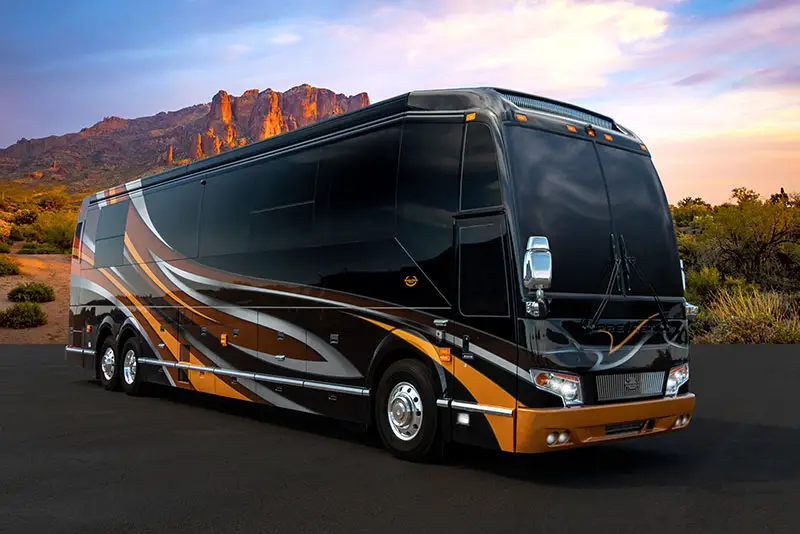
Bus conversions come in many types, and the kind we are talking about here are commercial bus conversions.
School bus conversions are called Skoolies and are typically DIY – the bus conversions we are talking about here are done professionally on charter busses and the like.
Bus conversions are very expensive and not as common as the rest of the RV types, but you’ll still see many of them on the road.
Pros and Cons of Bus Conversion Coaches
Pros
- Built well and last a long time.
- Luxury design and amenities.
- They drive comfortably once you learn how to handle them.
Cons
- Very expensive to purchase.
- Expensive to maintain and repair.
- Large size makes trip-routing and campsite-finding trickier.
Types of Towable RVs
There are many types of towable RVs, but they can really be classified into 3 types: fifth wheels, travel trailers, and truck campers.
Smaller campers like teardrop trailers, hybrids, and pop-up campers all fall under the “travel trailer” umbrella, but we’ll dive into each of them here.
Fifth Wheels aka 5th Wheels aka Fivers
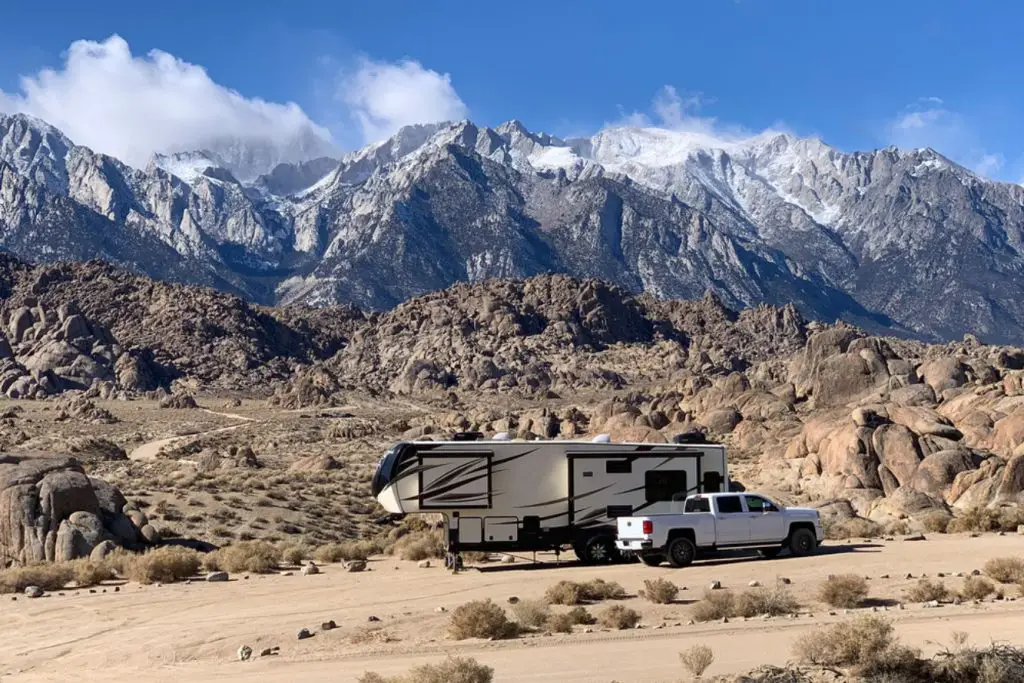
Fifth wheels are the largest type of towable RVs. These trailers are easy to spot: they hook up to a truck via a fifth wheel hitch or gooseneck hitch in the bed of the truck.
Having the fifth wheel hitch in the bed of the truck provides a more comfortable and stable towing experience when compared to bumper-tow trailers.
Due to their size and construction, fifth wheels have the largest variety of floor plan styles of any RV type. They can also have multiple bedrooms or even a dedicated office space.
Fifth wheel floor plans exist with front kitchens, mid kitchens, or rear kitchens… As well as front, mid, or rear living. Some fifth wheels can even comfortably sleep up to 10 people!
They range in size from around 30 feet to longer than 40 feet – these are big campers.
Pros and Cons of Fifth Wheels
Pros
- Largest variety of floor plan styles of any RV.
- Less expensive than motorhomes.
- Available in a wide range of quality and price points.
- Very residential-feeling.
Cons
- Most expensive towable RV type.
- Heavy and requires a large truck to tow which can get expensive.
- Large and tall – requires careful trip and campsite planning.
Related Reading about Fifth Wheel RVs:
Travel Trailers aka Bumper Pulls
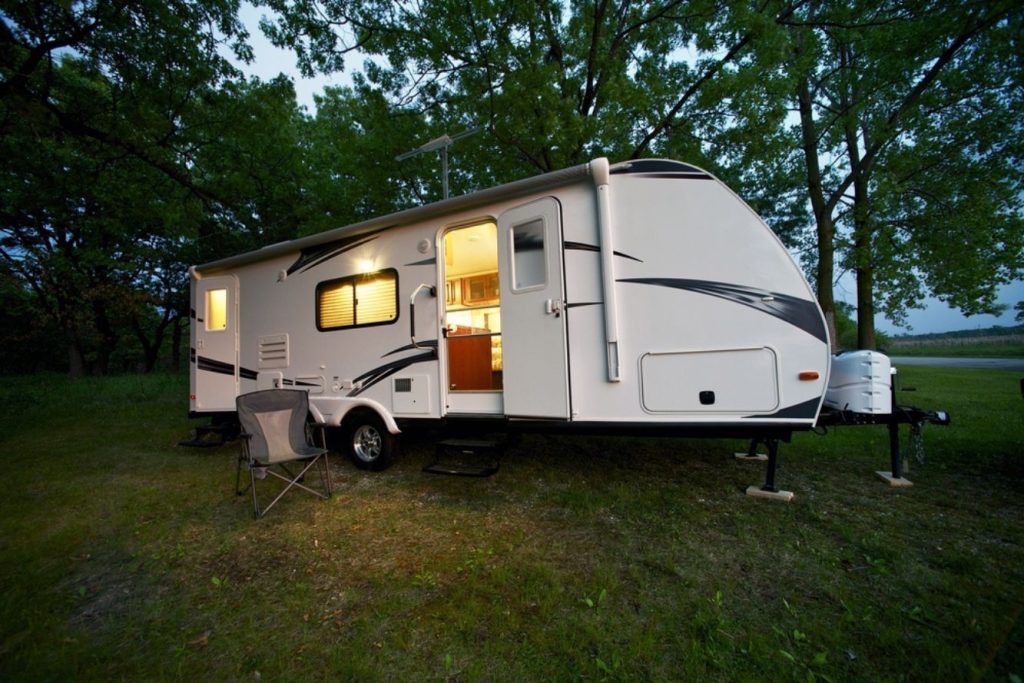
Travel trailers are a type of camper that connects to the tow vehicle via the hitch on the bumper. So, they don’t always require a truck. Some cars and most SUVs can tow travel trailers, depending on the overall size, weight, and towing capacity combination.
Travel trailers are the most accessible RV type for everyone. From new RVers to those on a budget, experienced RVers and those who want luxury: there’s a travel trailer for everyone.
Travel trailers come in many lengths: from less than 19 feet long to upwards of 40 feet!
Although travel trailers have long models available, it’s important to keep in mind that you also need to factor in the overall length of your vehicle.
Travel trailers also come in many quality types and price points, too, making them truly accessible for anyone looking to get into RVing.
Pros and Cons of Travel Trailers
Pros
- Least expensive of towable RV types.
- Wide variety of lengths, qualities, and price points.
- Can be towed with SUV or truck s
- Low insurance costs.
Cons
- Some mass-manufactured travel trailers have low quality.No access to the interior while driving.
- Less storage than fifth wheels or motorhomes.
Related Reading about Travel Trailers:
Toy Haulers
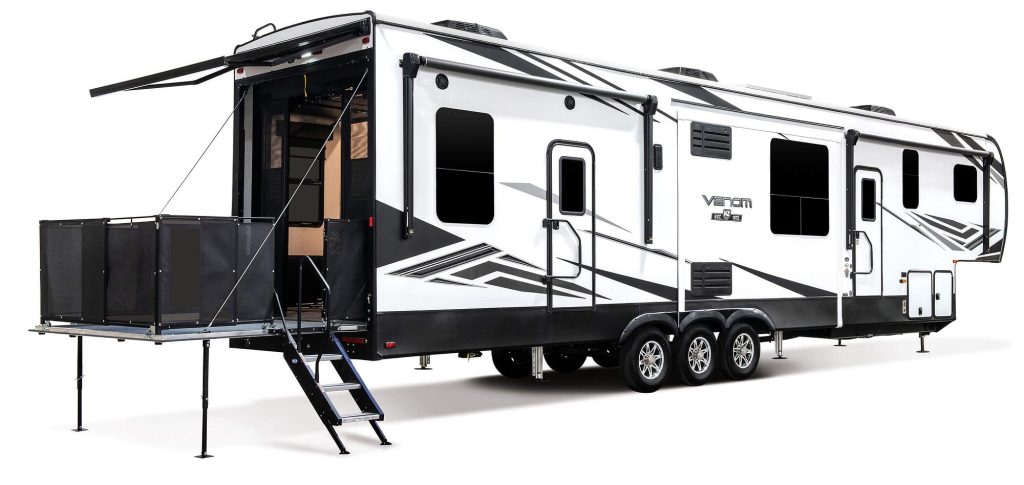
Toy haulers are unique because they can be a travel trailer, fifth wheel, or a motorhome.
A toy hauler is an RV with a dedicated “garage” space and ramp that can carry motorcycles, dirt bikes, or ATVs depending on the size and weight capacity.
You can even find tiny travel trailers that serve as toy haulers for bringing along outdoor gear like kayaks and bicycles.
It’s most common to see toy haulers as fifth wheels or travel trailers, although there is one motorhome model being manufactured today that has a garage space, the Thor Outlaw.
Pros and Cons of Toy Haulers
Pros
- Gives you the ability to bring along equipment.
- The garage space can be converted into an epic master or kids bedroom, office, or workshop with a view.
- Some of them have ramps that convert into a fenced-in patio.
Cons
- Not as well insulated as other RV types.
- If not enclosed, the smell of gasoline from your equipment can permeate your living space.
- Can be heavy and require a large and expensive truck to tow.
Truck Campers aka Slide In Campers or Backpack Campers
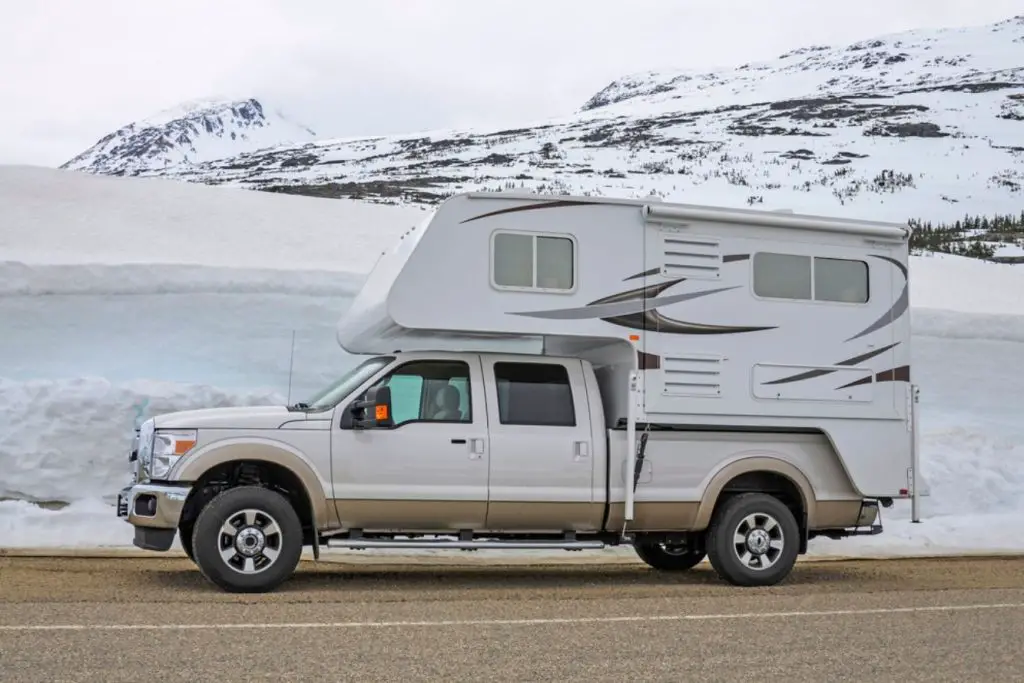
Truck campers are a type of camper that sits entirely inside the bed of a pickup truck.
Since truck campers sit in the bed, the number that matters on the truck is the total payload capacity – not the towing capacity.
Truck campers have many advantages, but their biggest disadvantage is the weight and type of truck you need to safely haul one.
These campers are great for solo travelers or couples who don’t want to worry about towing something behind their truck. You can go just about anywhere with a truck camper and fit in almost any parking spot.
Pros and Cons of Truck Campers
Pros
- Can go just about anywhere.
- Come in many different types and amenities – some even have slide outs, washer/dryer, and bathrooms.
- Great for couples and solo travelers.
Cons
- Very small space, many don’t even have a bathroom or toilet.
- Very heavy and typically requires a large truck.
- Can be top-heavy, making off-roading difficult.
- Expensive.
Pop Up Campers aka Tent Trailers
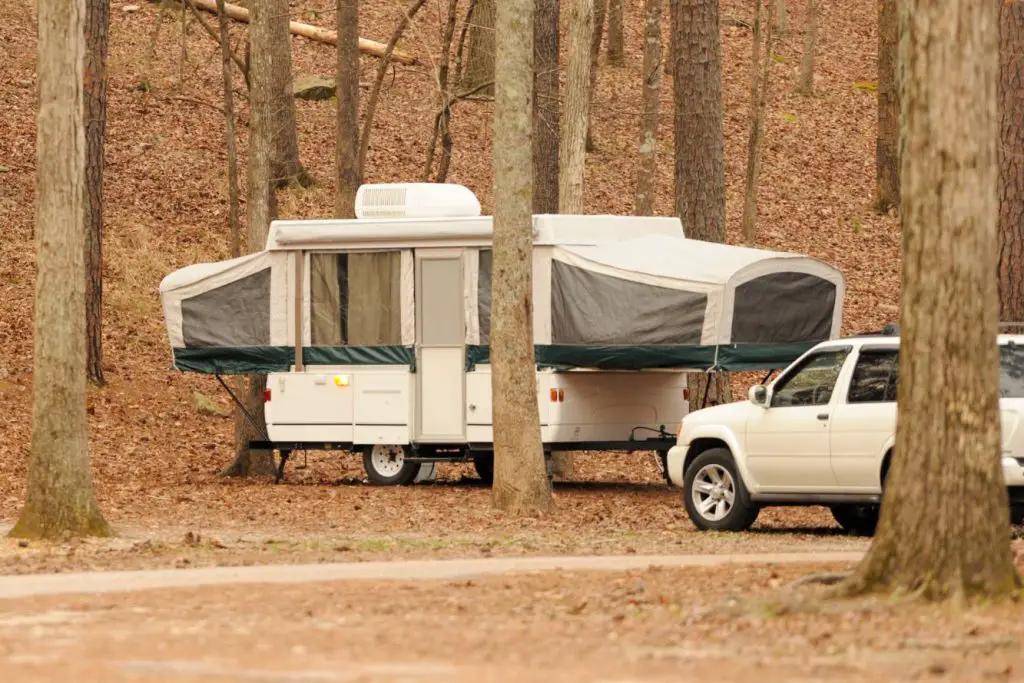
Pop up campers, also called tent campers, are a type of camper that literally pops up. These campers are small but expand when you set them up and are like a hybrid between a tent and a camper trailer.
When folded down for storage or travel, pop up campers are short enough that you can still see out your back windshield when driving. When set up, they can range in height.
The tent portion of pop up campers is made from a heavy duty weatherproof canvas. Although it’s weatherproof, it offers almost no insulation. However, many pop up campers will come with a heater and AC unit to help keep it comfy.
Some have bathroom or toilet areas, and most come with two beds on either pop-out section, a sink and fridge, and a stove top.
Pros and Cons of Pop Up Campers
Pros
- Inexpensive.
- Easy to tow.
- Great for family camping trips.
Cons
- Very difficult to regulate temperature – best for fair weather.
- Not great for long-term trips or full-timing.
- Small space.
- Lack of privacy: no noise insulation.
Related Reading about Pop Up Campers:
- Do Pop Up Campers Have Air Conditioning & Does it Actually Work?
- 11 Best Pop Up Camper Air Conditioners to Beat the Summer Heat
- 9 Best Pop Up Camper Bike Racks and Mounting Guide
Hybrid Campers
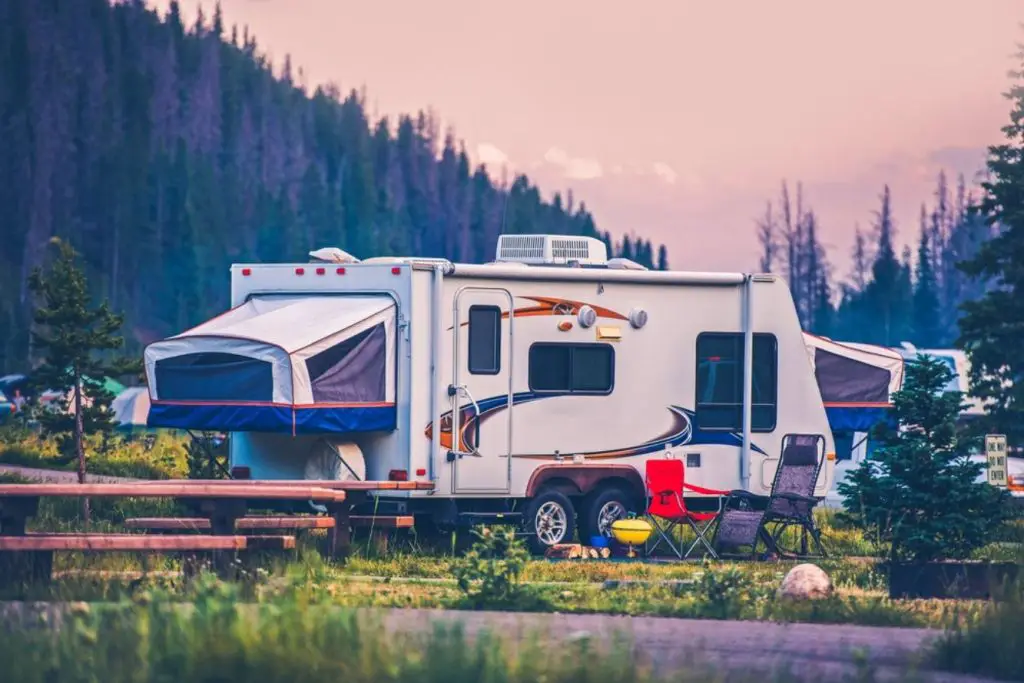
A hybrid camper is a unique type of camper – it’s like a cross between a travel trailer and a pop up camper.
When all folded up, these campers look like your typical small travel trailer. But when they’re set up at camp, hybrid trailers have tent camper pop out sections just like a pop up camper.
These campers utilize a pop-out section to give the RV more space inside when all set up, yet remain lightweight enough to be towed by midsize SUVs and even some cars depending on the towing capacity.
These pop outs give the same benefit of a slide-out without the weight and hassle of the machinery.
Pros and Cons of Hybrid Campers
Pros
- Pop outs create more interior space in the camper.
- Lightweight enough for most midsize SUVs and even some cars.
- Great for family camping trips.
- Still gives that “camping” feeling even though you’re in an RV.
Cons
- Difficult to regulate temperature.
- Not good for long-term trips or full-time travel.
- Lack of privacy: no noise insulation.
Teardrop Campers
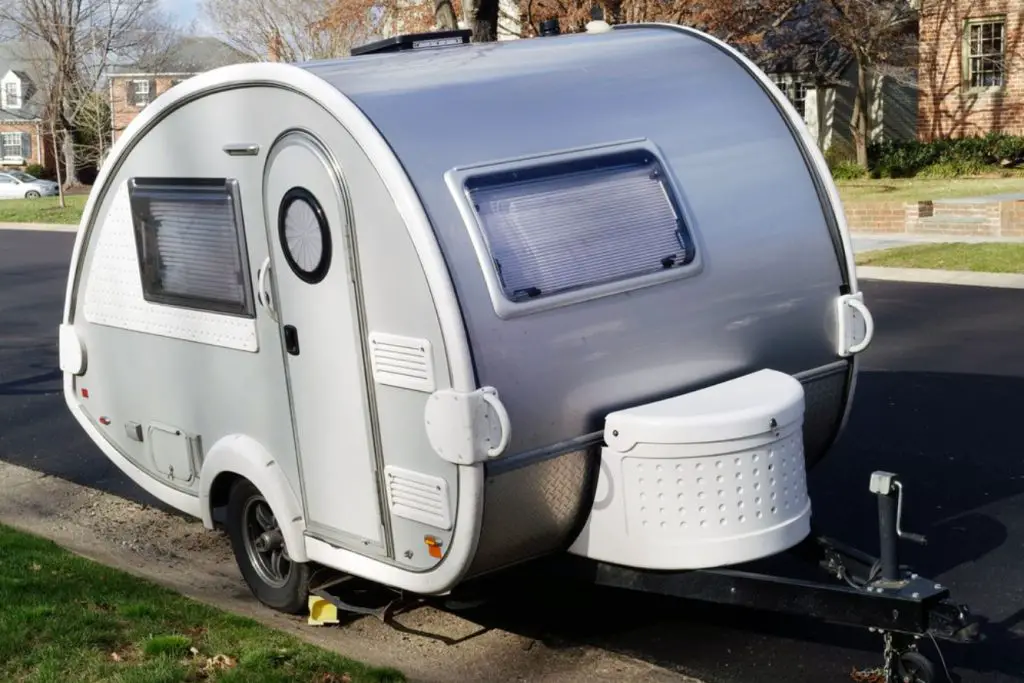
We’ve probably all seen teardrop campers – the cute little campers that seem to be shaped like a teardrop!
These days there are a lot of different kinds of teardrop campers on the market. From small teardrops that you can barely sit up in, to the bigger teardrop campers you can stand in like the Little Guy Mini Max, there’s a teardrop for anyone.
These campers are unique and lightweight – there are even teardrop campers that are small enough to tow with a motorcycle.
Pros and Cons of Teardrop Campers
Pros
- Small and lightweight
- Can tow with any vehicle
- Great for solo or couple camping trips
Cons
- Smallest space of any camper
- Many only have a bed and a small cabinet – no kitchen space, bathroom, etc.
FAQ About RV Types and RV Classes
Here are some answers to the top FAQ about RV types and classes.
What Are RV Classes?
An RV Class is a classification about what type of RV it is. RV Classes only apply to drivable RVs, or motorhomes. The drivable RV classes are Class A, Class B, Class B+, Class C, and Super C RVs.
However, many people use the word “class” to describe towable RVs too. In simple terms, an “RV Class” is a differentiation to tell you what style of RV it is.
What Does RV Stand For?
RV stands for Recreational Vehicle. This term is used to describe both drivable and towable campers.
RVs are vehicles made for outdoor recreation like traveling, camping, etc, so the name is well fitting.
What is the Difference Between RV and Camper?
The terms “RV” and “camper” are generally interchangeable. They both refer to recreational vehicles and trailers used for traveling and camping.
While some may argue that “RV” means a large motorhome and “camper” means a small travel trailer, the truth is that they both refer to any and all camper vehicles and trailers.
What is the Most Popular RV Type?
According to the RV Dealership Association (RVDA), travel trailers are the most popular RV type, followed by fifth wheels. Here are the most popular RV types in order, according to sales data from RVDA:
- Travel Trailers
- Fifth Wheels
- Class A
- Class C
- Class B
